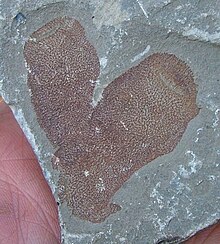| Hazelia Temporal range: | |
|---|---|
 | |
| A specimen of Hazelia at the Mount Stephen Trilobite Beds | |
| Scientific classification | |
| Domain: | Eukaryota |
| Kingdom: | Animalia |
| Phylum: | Porifera |
| Class: | Demospongiae |
| Order: | † Protomonaxonida |
| Family: | † Hazeliidae |
| Genus: | † Hazelia Walcott, 1920 |
| Species | |
Hazelia is a genus of spicular Cambrian demosponge known from the Burgess Shale, the Marjum formation of Utah, [4] and possibly Chengjiang. [1] It was described by Charles Walcott in 1920. [5]
Its tracts are mainly radial and anastomose to form an irregular skeleton. [4] Its oxeas form a fine net in the skin of the sponge. [4]